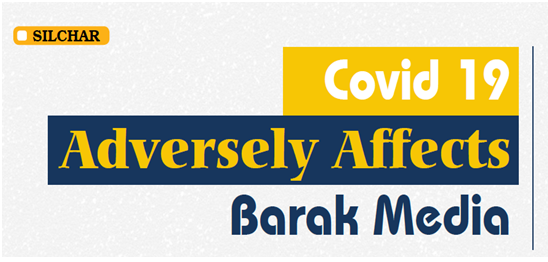
Covid 19 has adversely affected Barak media, print and electronic. A booming industry is faced with unprecedented crisis in its 140 years of history. According to available records, ever since the publication of the first newspaper of this valley ‘Silchar’ in 1889 edited by Bidhu Bhushan Roy, a school teacher, it has been a well admired and well appreciated human efforts to enlighten and inform the readers of the events happening around. Till Independence of the country, under British Raj, the editors have to be cautious in editing the newspapers as nothing anti colonial rule finds place on the pages. Still, editors like Bidhu Bhusan Roy dared to criticise and face reprimand and shut down the newspaper.
But this could hardly dent the spirit of those who chose to edit and publish newspapers in the pre independent era or colonial rule which began in this valley in 1832 and inflamed the passion of freedom lovers without going for direct criticism of the British. And the hoary tradition of journalism was glorified by the publication of ‘Surma’, ‘Bhavishyat’, ‘Bartaman’, ‘Saptak’ and ‘Prachyavarta,’ all weekly. After the British left, newspapers got the liberty it deserves and also support from the democratic government. From this valley, newspapers in Bengali, Hindi, English, Manipuri and Bishnupriya Manipuri have been published. Quite significantly, around 200 dailies, weeklies and biweeklies have hit the stands from the three districts of Cachar, Karimganj and Hailakandi till date from the day of ‘Silchar’.
With strong readership base, both in urban and rural areas, it has been a booming media industry. It is a matter of pride that as on date, 9 dailies, 6 Bengali Jugashankha, Samayik Prasanga, Prantajyoti, Gati, Nabavarta Prasanga and Abichar, 1 Hindi Prerana Bharati and 2 English Eastern Chronicle and North East Express blaze the trail, besides a number of weeklies including Challenger Varta in English from the valley. Noted journalists from Mount Abu Institute of Journalism, Kamal Dixit and B K Sumanta in course of their media study tour across the hotspots of newspapers of the country some time back wondered at the patronage of readers here, something unparallel as said by them. They were also surprised at the coverage of reports like national newspapers.
Unsaid but true, the newspaper industry has not the good time under lockdown. With that the hawkers have had the most trying time of their job. Declining circulation, cut in pages and coverage, low revenue generation from shrinking readership and advertisements of private companies, shut down of transport services, closure of shops and business interests, tea stalls and restaurants have all combined together to tell upon the media. Centre and state NRHM (National Rural Health Mission) advertisements do come to help the newspapers to keep going. Journalists and non journalist employees have also been hard hit as a sequel to the adversity. Of relief is that media houses in economically weak zones have not to bother about the Majithia Wage Boards’ recommendations.
Another interesting but disturbing phenomenon that has emerged during the lockdown period about decline in readership in urban areas is the fear among a section of readers that newspapers might carry the killer virus.
Jyotilal Chowdhury
To read the further articles please get your copy of Eastern Panorama June issue @http://www.magzter.com/IN/Hill-Publications/Eastern-Panorama/News/ or mail to contact @easternpanorama.in



